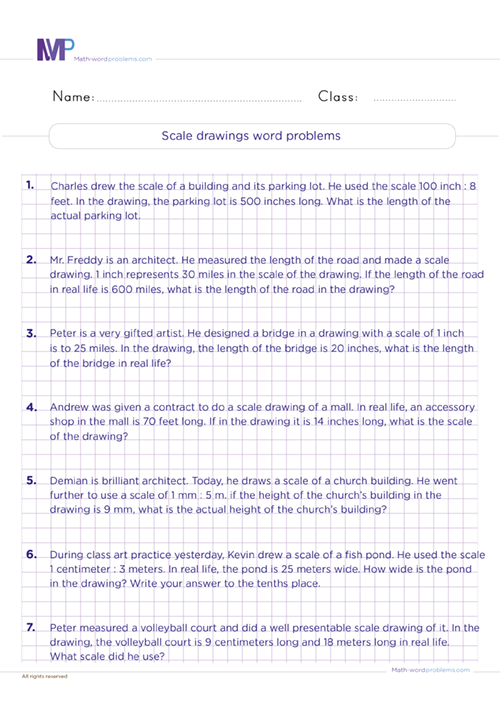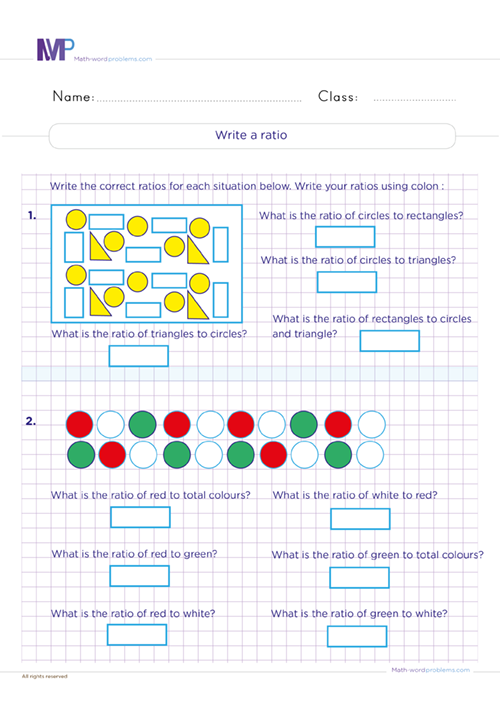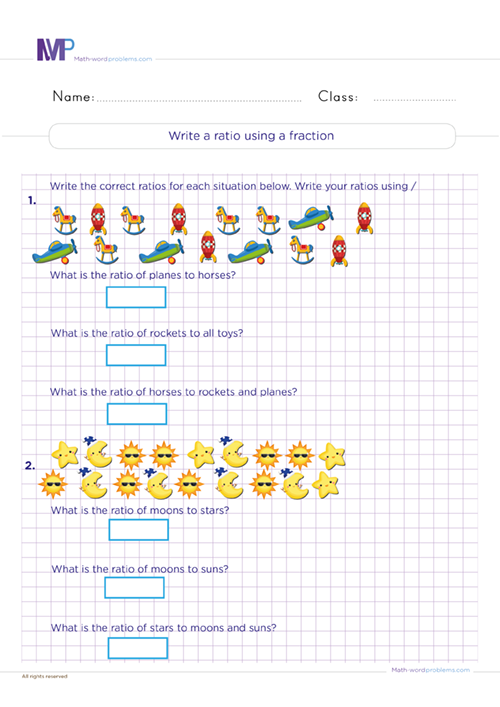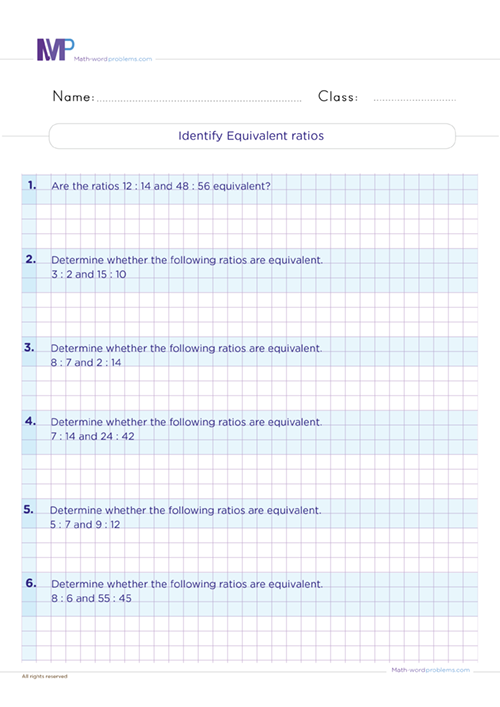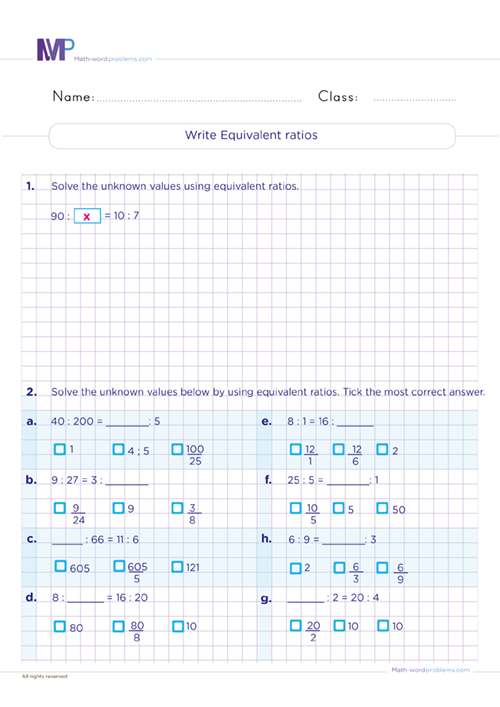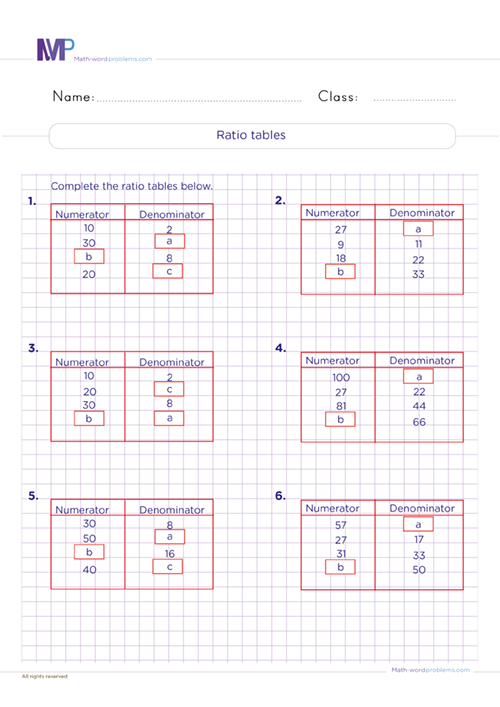 Ratio and rates worksheets Grade 6
Ratio and rates worksheets Grade 6

- INTRODUCTION
- Download worksheets
- Related Contents
- Fast ways to describe math and real-life relationships using...
Get more contents on Ratio and rates Grade 6...
Our ratio and rates worksheets Grade 6 are designed with various fun activities for 6th graders to gain a better mastery of writing ratios, writing a ratio using fractions, identifying and writing equivalent ratios, etc. As for writing ratios, remember that we write ratios using words, fractions, or colons. By way of example, these concepts allow you to compare quantities, measure relationships, and solve problems in a variety of contexts. Thus, as you engage in this resource, you will discover how ratios, rates, and proportions can help you in math and everyday life.
However, our fun methods and strategies will enrich kids' confidence and accuracy in writing and accurately solving ratio and proportion problems.
Apart from designing simple exercises, our ratio and rates worksheets also consist of scale drawing word problems perfect for learning how to make comparisons or relationships between things in our daily lives. Moreover, understanding ratios and proportional reasoning is a building block for plenty of math and advanced proportional reasoning and algebra.
Ratio and proportion worksheets with answers Grade 6
Grab the best of our fun and engaging ways to practice ratio and proportion worksheets with answers Grade 6. We will provide exciting methods and strategies to solve all math problems related to ratios, rates, and proportions. Also, we hope to enhance young math learners' division and multiplication reasoning by encouraging them to simplify, find equivalent ratios, and multiply or divide both terms by the same number. Note that equivalent ratios have the same value but use different numbers.
It is equally interesting to note that ratio and rates worksheets in Grade 6 come with solution and answer sheets showing detailed step-by-step procedures for solving each exercise. By so doing, kids will learn tips and tricks on approaching different types of problems while avoiding common errors. Besides, the solution and answer sheet will enhance quick correction once you make a mistake. Thus, a perfect way to improve your confidence and accuracy in solving ratio and proportion problems.
These solution and answer sheets and consistent practice of ratio, rates, and proportion worksheets Grade 6 is of high quality and carefully designed to develop 6th graders' proportional reasoning skills by solving problems that involve different units or scales. For instance, if one gallon of gas costs $4.15, you will easily find the cost of 16 gallons using proportional reasoning.
Fast ways to describe math and real-life relationships using ratio and rates worksheets Grade 6
Our outstanding techniques and use of tables, graphs, equations, or words are fast ways to describe math and real-life relationships using ratio and rates worksheets Grade 6. For instance, tables and graphs will help students visualize how two quantities change in relation to each other. Equations help in finding missing values or simplify expressions involving ratios and rates. While words help in explaining reasoning or communicating solutions. These worksheets are perfect for classroom and home use as they cover important concepts such as unit rates, unit conversions, proportions with cross products, percent problems, scale drawings, similar figures, indirect measurement, and many more.
Above all, our objective in this resource is to help 6th graders master how to:
-
Compare quantities using fractions, decimals, percentages, and ratios. For example, how to write 3 out of 5 as a fraction, a decimal, a percentage, and a ratio.
-
Find equivalent ratios using cross multiplication or simplification. For example, how to determine if 4:6 is equivalent to 8:12 or not.
-
Simplify ratios using common factors or prime factorization. For example, how to simplify 18:24 to its lowest terms.
-
Solve word problems involving ratios and rates. For example, how to find the unit rate of a car that travels 240 miles in 4 hours.
-
Apply ratios and rates to real-world situations such as scale drawings, maps, recipes, proportions, and more!
Fun examples with tips on how ratio and rates worksheets Grade 6 can enhance kid's mastery of ratio, rates, and proportion in math and real life
Before going through our fun examples with tips on how ratio and rates worksheets Grade 6 can enhance kids' mastery of ratios, rates, and proportions in math and real life, let's quickly review ratios, rates, and proportions.
-
A ratio is an ordered pair of two quantities compared by dividing. For example, if you have 12 apples and 4 oranges, the ratio of apples to oranges is 12:4 or 3:1.
-
A rate is a comparison of two quantities having different units. For example, if you drive 60 miles in 2 hours, the rate of speed is 60 miles per 2 hours or 30 miles per hour.
-
A proportion is an equation wherein two ratios are equal to each. For example, if you know that 3 cups of flour make 12 muffins, you can write the proportion 3/12 = x/24 to determine how much flour you need to make 24 muffins.
Now that we have refreshed our memory on these definitions let's see how they can help us in real-world situations. Here are some examples:
- Comparing prices: Suppose you want to buy a new laptop and have two options: Option A costs $800 and has a battery life of 10 hours; Option B costs $900 and has a battery life of 12 hours. Which one is a better deal? To answer this question, we can use rates to compare the cost per hour of battery life for each option. Option A has a rate of $800/10 hours = $80 per hour; Option B has a rate of $900/12 hours = $75 per hour. Therefore, Option B is cheaper per hour of battery life and might be a better choice.
- Measuring ingredients: Suppose you want to make a cake, and the recipe calls for 2 cups of sugar and 3 cups of flour. However, you only have one measuring cup that holds half a cup. How many times do you need to fill it with sugar and flour?
To answer this question, we can use proportions to find equivalent ratios for the ingredients. We can write the proportion 2/3 = x/0.5 to find out how much sugar we need in terms of half-cups. Cross-multiplying gives us x = (2*0.5)/3 = 0.33 half-cups or about one-third of a half-cup. Similarly, we can write the proportion 3/2 = y/0.5 to find out how much flour we need in terms of half-cups. Cross-multiplying gives us y = (3*0.5)/2 = 0.75 half-cups or about three-fourths of a half-cup.
- Scaling drawings: Suppose you want to draw a map of your neighborhood on a piece of paper 8 inches by 10 inches. You know that your neighborhood is about 1 mile by 1 mile in size (5280 feet by 5280 feet).
How big should each block be on your map? To answer this question, we can use proportions to find the scale factor for the drawing.
We can write the proportion 8/5280 = x/1 to determine how many inches on the paper correspond to one foot.
Cross-multiplying gives us x = (8*1)/5280 = 0.0015 inches per foot.
Similarly,
We can write the proportion 10/5280 = y/1 to determine how many inches on the paper correspond to one foot.
Cross-multiplying gives us y = (10*1)/5280 = 0.0019 inches per foot.
Therefore,
each block on our map should be about (0 .0015 *528) by (0 .0019 *528) inches,
which is approximately (0 .79) by (1 .00) inches.
So, as you can see, ratios, rates, and proportions are convenient tools you can use in many areas of life.

